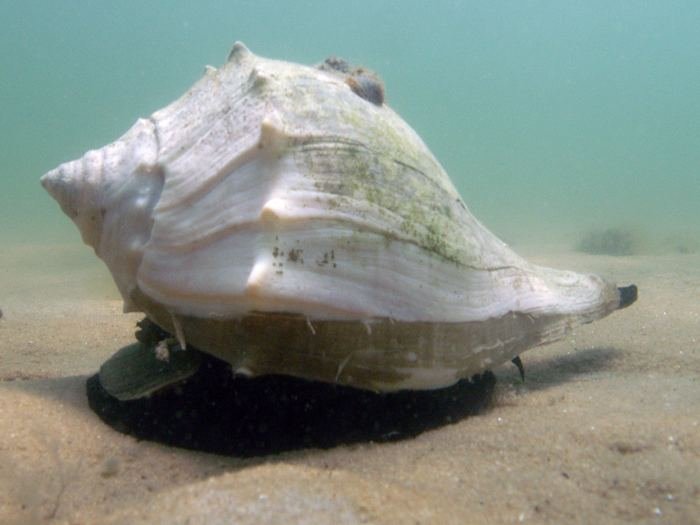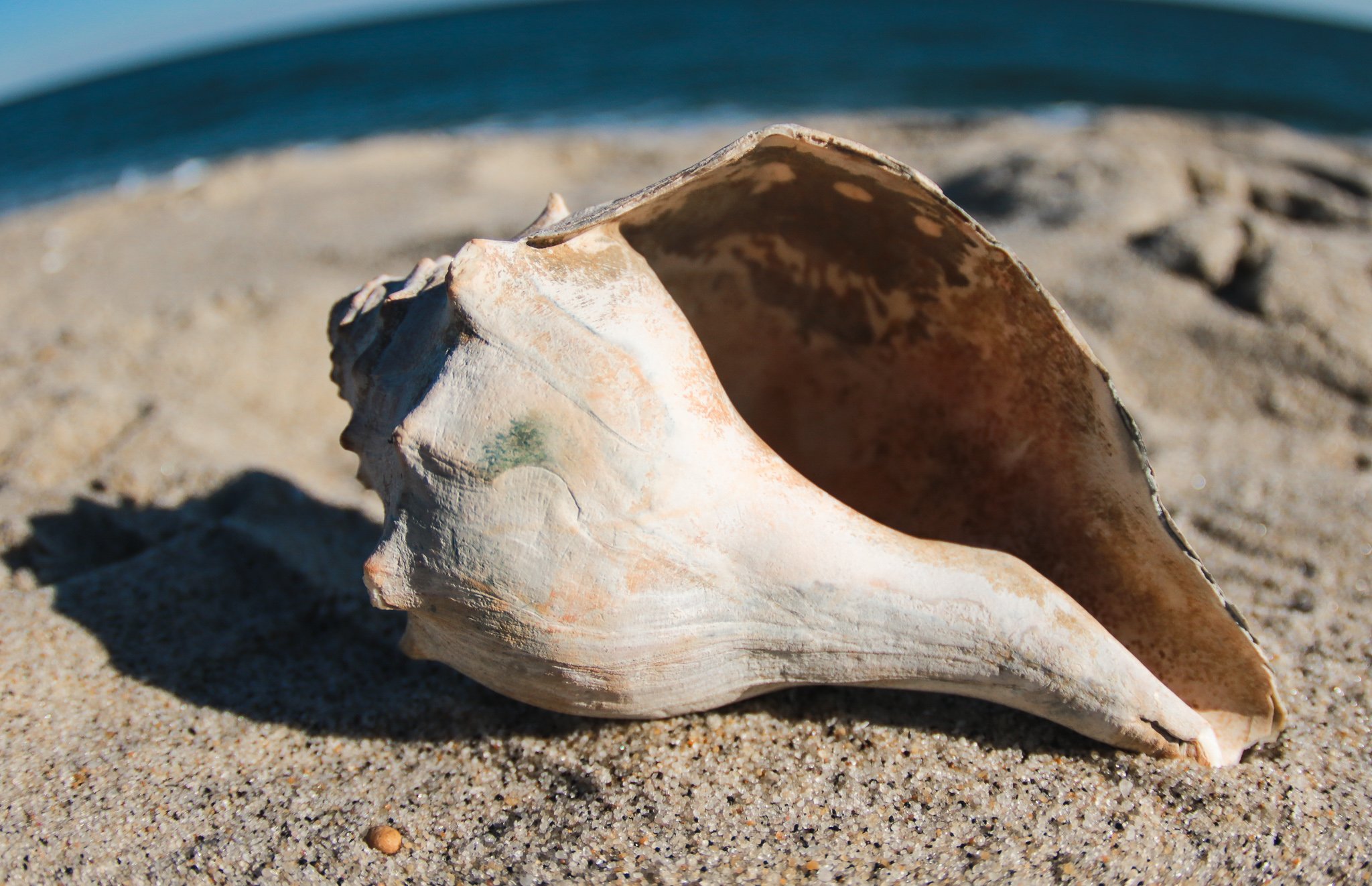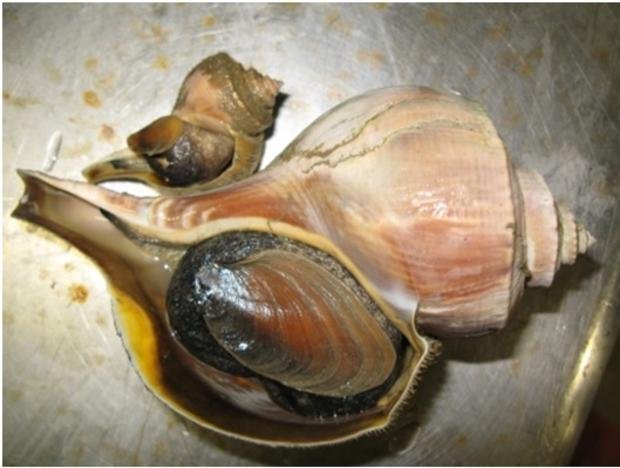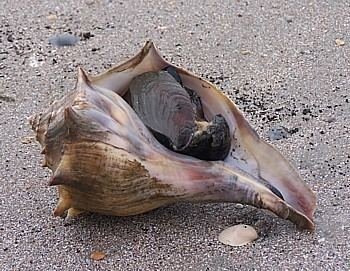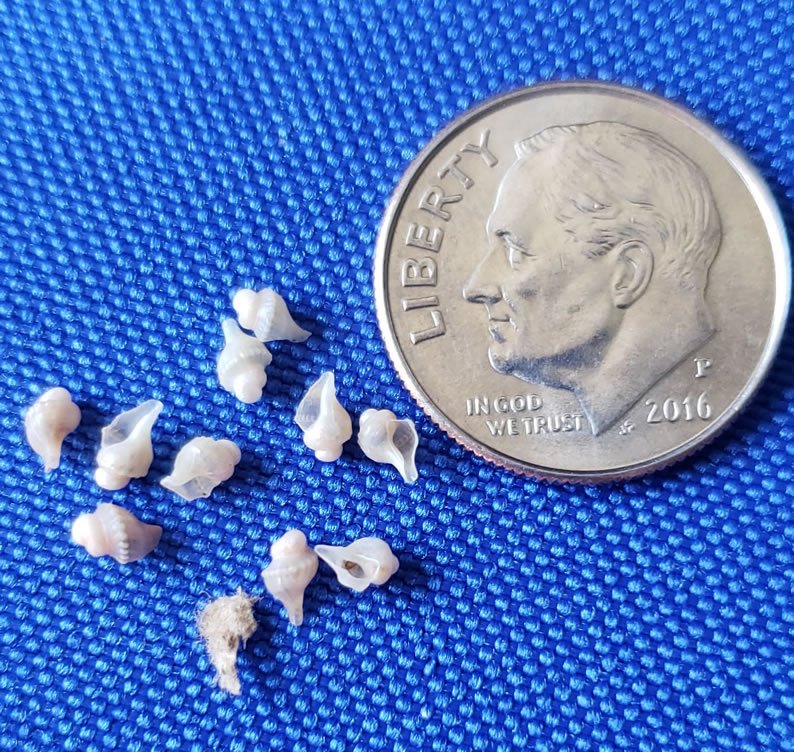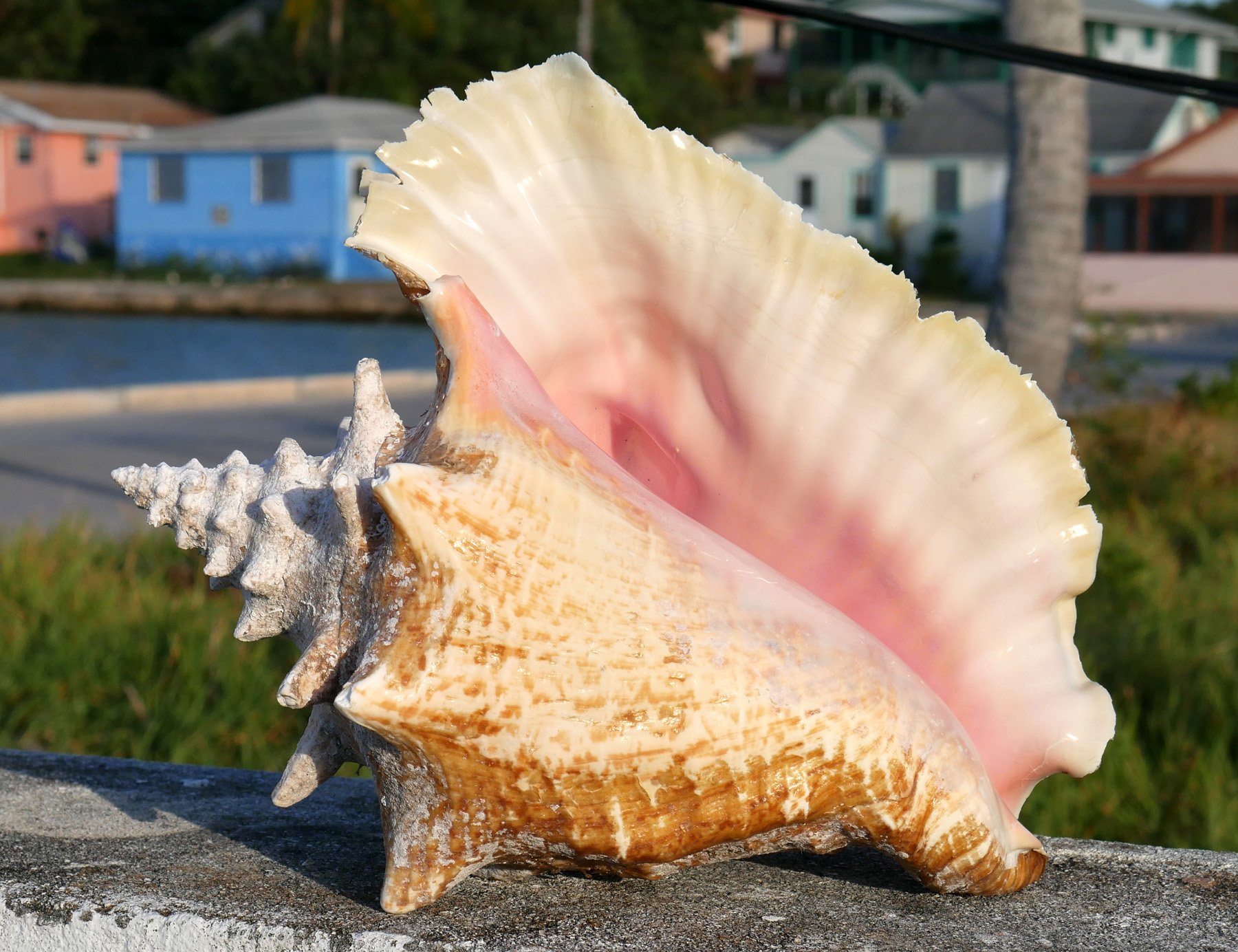Knobbed Whelks: More than Just the State Shell of New Jersey
Written by Joseph Reynolds, President/Director of Save Coastal Wildlife Nonprofit
The empty shell of a knobbed whelk (Busycon carica) found along the Jersey Shore.
Do you know the knobbed whelk (Busycon carica)? No, I am not talking about a conch. The two often get confused by people. More on that later.
Perhaps if you are lucky, you may have found an empty knobbed whelk shell while walking along the edge of the Jersey Shore on a sunny, summer day. To find one, especially one that is intact, is a special shoreline treat. Who knows when you might find another beautiful unbroken knobbed whelk shell, since their population is largely unknown in New Jersey.
Knobbed whelks have a strikingly smooth and a unique pear-shaped spiral shell that is surrounded by several wonderful triangular knobs or bumps on its shoulder, hence the name “knobbed.” The aperture (opening) of this sea creature is on the right side as you look down.
It can be a colorful shell. Find a freshly washed-up knobbed whelk and you will be greeted with a solid cream, grey or tan colored shell, with a cream or orange interior. Juveniles are marked with brown and white streaks, which fade as they get older.
Colorful juvenile knobbed whelk shells found along the Jersey Shore.
So delighted have people been with the beautiful color and contours of a knobbed whelk shell that New Jersey Governor Christine Todd Whitman on April 13, 1995 made it the official state shell of New Jersey. In 1987 the knobbed whelk was designated as the official state seashell in the State of Georgia.
But there is more to a knobbed whelk than just a pretty shell. There is something living inside that cute pear-shaped shell. Surprise! It’s a snail!
Image from Alchetron Sea snail
Land snail
Whelks belong to a large taxonomic class of invertebrates commonly known as gastropods. It comprises snails and slugs from all over the world, both on land and in freshwater and saltwater. There are 65,000 to 80,000 living snail and slug species globally, including over 50 species of whelks.
Knobbed whelks are marine gastropods that live in coastal waters and tidal estuaries along the Atlantic coast, from Cape Cod, Massachusetts to Cape Canaveral in Florida, and along the Jersey Shore, from Raritan Bay down to Delaware Bay.
Knobbed whelks have a slimy muscular foot on the bottom of their body that is used for locomotion, and a siphon on top of its head to draw in oxygen rich water to breath. Two pairs of tentacles are also located on its head: one senses light, while other shorter tentacles are used for touch and smell that help a whelk search for food. Whelks are carnivores and mainly feed on worms, clams, mussels, other snails, and even dead organisms.
Can you hear the ocean by putting a whelk shell to your ear? According to Science Focus, the sound you really hear inside a shell is actually ambient white noise that gets amplified. Surrounding noises, such as wind, distant traffic, birds or other sounds around a beach enter a large whelk shell, bounce around and get combined into a type of white noise or hum, thus emitting the sound we know as the “ocean.”
With generally poor eyesight, knobbed whelks depend on their sense of smell to find a meal. Water enters a siphon and chemoreceptors in the head locate prey by detecting chemical stimuli in the water. This information is relayed to a whelk’s central nervous system, which moves a snail’s body in the direction of its prey.
Once a target is found, a whelk will use the sharp tip of its shell to pry open a prey’s shell. A whelk can also use its strong muscular foot to separate the two shells of a bivalve like a mussel or clam. A whelk will feed by grasping a prey’s shell and extending its proboscis, a tube-like feature with a mouth and radula or tiny teeth used for scraping food particles, to eat its victim inside its own shell or exoskeleton.
If that feeding strategy doesn’t work, a hungry whelk can always use an acidic secretion to soften its prey’s shell and then drill a hole with its radula to begin to suck the juices and soft meat inside a victim’s own exoskeleton. When it comes to food, whelks don’t fool around.
During the winter, whelks will often migrate from shallow waters in an estuary to deeper waters offshore to a depth of about 150 feet to feed. It is an amazing and bewildering journey considering an adult whelk can only move around about 3.9 inches per minute.
Snails make up for a lack of speed with a solid shell. An important tool for sure. A hungry predator, and there are many out there, such as a gulls, crabs, sea turtles, sea stars or other sea urchins, will not find any easy meal due to a whelk’s hard outer skeleton.
A hard plate or lid called the operculum and located on a knobbed whelk’s foot acts like a trap door to forcibly shut the aperture or opening so a snail can retract inside its shell for safety. Predators will often have difficulty smashing through the strong shell and operculum of an adult whelk, but juveniles who generally have thinner shells are vulnerable to attack from predatory animals.
Knobbed whelks begin life as a small crawling snail that emerges from an egg capsule. An adult pregnant whelk will lay a string of spiraling eggs cases that it will deposit in the water twice a year, usually from April to May and September to October. Each fertilized egg capsule, which looks like a long line of yellow bubble wrap, is regularly strung together in a spiral with many other capsules, sometimes a foot or more in length and containing over 50 capsules. This string of capsules is called an egg case.
Each tiny snail that emerges from an egg case is born with a shell. It will take 3 to 5 years before a juvenile whelk reaches maturity. Adult knobbed whelks measure five to nine inches in length and can live up to 40 years.
Each whelk is born with it’s own shell or outer skeleton. Picture from the New Jersey Division of Fish & Wildlife
In addition to the knobbed whelk, there are other snails that call our local coastal waters home. The channel whelk (Busycotypus canaliculatus) does not have a shell that is knobbed or lumpy but has a smooth broad whorled body. It is generally smaller in length that a knobbed whelk.
Knobbed Whelk (left), and a Channel Whelk (right).
Farther south, including in Virginia and the Carolinas, you may find lightning whelks (Busycon sinistrum) and pear whelks (Busycon perversum). The knobbed and lightning whelks look very similar to one another, but the lightning whelk's opening is on the left side, where the knobbed and channel whelk's opening is on the right side. A pear whelk looks something like a lighting whelk, but is smaller, and has its opening on the right side, like a knobbed and channel whelk.
In tropical waters there are several species of conchs, including the Queen conch (Strombus gigas), a large marine snail that lives in the Caribbean Sea. In New Jersey, whelks are often called conchs, but this wrong. Even though they are related, there are differences between whelks and conchs. For starters, whelks prefer the chilly water of the North Atlantic Ocean, while conchs favor warmer tropical waters. Whelks are also carnivores, whereas conchs are herbivores.
Image from Abaco Sun. A queen conch.
A pair of Queen Conchs from the Caribbean
But no matter if it’s a whelk or conch, these marine snails do not have any easy life. Not only do snails have to deal with the constant threat of predators, but there are many active commercial fisheries for marine snails. In New Jersey and in many northeastern and mid-Atlantic states the fishery is for channel and knobbed whelks.
It’s a productive market. A large channel whelk can be sold for as much as $7 in a fish market before being shipped to China or to Asian markets in Boston and New York where they fetch double the price. They’re a prized international commodity in Cantonese cooking. Whelks are also used in European dishes, such as scungilli or in sea snail salads.
Smaller channel whelks can be sold by the pound for $5.00. Knobbed whelks for $1.00 a pound, which cost less since they have thicker and heavier shells. In 2016, the annual dockside value of whelks was $1 million in Virginia and Rhode Island, $1.4 million in New Jersey, and $5.7 million in Massachusetts, according to marine fishery agencies in those states. In Delaware, knobbed and channeled whelks were the third most valuable fishery behind blue crabs and striped bass.
Several different species of large whelks in the family Buccinidae on sale at a fish market in Japan. Image from Wikipedia.
There is also a cottage industry that sells whelk shells in the tourist trade as ornamentals. Scan the pages for whelk shells on eBay or Etsy to sadly see what I mean.
The problem with this high demand for whelk shells is that many marine fishery agencies along the East Coast of the United States have a poor understanding of the population of whelks. A search of the scientific literature on population studies for knobbed or channel whelks or even just whelks reveal little data. Shockingly, New Jersey does not currently manage whelks, but whelks are caught in New Jersey by commercial crab fishermen. There is a size limit of 5 inches for each live whelk harvested in New Jersey.
The only local scientific information on population status to be found is from the State of Massachusetts, and it does not provide a good future for whelks. The website for the Division of Marine Fisheries for the Commonwealth of Massachusetts states that it considers channel whelks to be “depleted throughout their range within the waters under the jurisdiction of the Commonwealth. A 2018 stock assessment of channeled whelk within Nantucket Sound showed this resource to be overfished with overfishing occurring.” In fact, a 2012 study suggested that portions of Buzzards Bay and Nantucket Sound were already devoid of whelk. So why does Massachusetts continue to allow a whelk fishery?
In New York State marine waters, perhaps due to overfishing, it has recently implemented new limits to harvest whelks. In 2021, the New York State Department of Environmental Conservation (DEC) announced proposed changes to whelk harvesting regulations in New York's Marine and Coastal District that will adopt a minimum size limit of 5½ inches in length or three inches in width for the harvest of channel and knobbed whelk to protect immature females in the population and increase their potential to reach reproductive maturity. This is good news but provides little in the way of population figures to determine if overfishing is occurring in state waters.
Commercial fishing for whelks along the Jersey Shore and in many northeastern states has increased in recent year, especially since lobster fishing has declined. After 2002 when the lobster population in Southern New England started to collapse, whelk fishing increased. In 2014, there were 200-plus whelk fishermen in Rhode Island.
Whelks are fished using pots or recycled plastic containers, which are weighted to stay on the sea floor. Baited pots are set in strings and attached to one another. Whelks are attracted to the pots by the scent of the bait. Pots can be left on the sea floor and hauled at intervals (1-3 days), then re-baited and set again. A small proportion of whelk catch is taken as bycatch in other fixed gears such as for crab and lobster pots.
Whelks have a lack of mobility and distribution, since they cannot move fast. These factors make the whelk vulnerable to overfishing. If overfishing occurs, the population recovery can take many years or decades. Yet, it’s difficult to estimate the number of knobbed whelks left in the world since their conservation status is not even evaluated by the IUCN Red List, which is the world's most comprehensive inventory of the global conservation status of plant and animal species. It’s assumed that many species of whelks are not endangered or nearing extinction since the commercial fishery for these snails is still lucrative.
Whelk shells can sometimes be found in a variety of colors. A white shell like the color or ivory usually means it was bleached by the sun from sitting outside for sometime. A dark shell might be an indicator that it was lying in mud. A tan or reddish shell perhaps means it was lying in a deposit of sand with iron sediment.
Whelks do have an important role to play in an aquatic ecosystem and deserve to be protected!
Some recent scientific studies show that excessive whelk shell removal from a beach could cause significant damage to natural ecosystems and organisms that rely on shells, such as algae, sea grass, and sponges. Hermit crabs also use whelk shells as a protective covering or a defense against predators. Some species of small or juvenile fish likewise use large whelk shells to hide from predators.
Furthermore, whelk shells are mostly made of calcium carbonate and dissolve slowly to recycle back chemicals into the ocean to help slow down ocean acidification. This is important since some evidence suggests that ocean warming and acidification due to an increase of CO2 emissions from global warming is causing some species of whelks to have thinner shells. This in turn can cause an increase in predation and a lower population of whelks.
Knobbed whelk shells are unquestionably treasures from the sea. Beautiful shells with distinctive wild organisms living inside that deserve to live a life without the possibility of becoming threatened or endangered species from poor planning and over-harvesting by the human species. When you find whelk shell on the beach, it might be best to take a picture. Who knows, it may be the last one you find.
Two Knobbed Whelks found along the east coast of the United States, but one shell (dark in color on left) was found in New Jersey and the other shell (lighter in color on the right) was found farther south in Florida. Warmer waters in the south sometimes allow knobbed whelks to grow a more noticeable series of protrusions around the shoulder of the shell.



